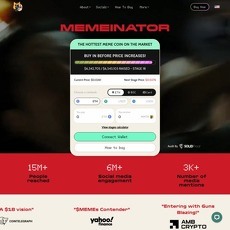Lyve Finance Review
Lyve Finance
lyvefi.xyz
If your website is on the scam list and you think that you are not a scammer, contact us. After you provide us with all the proof that you are in Crypto World with good intentions, we will delist you. Usually, you get in this category because you are hiding your team, you have a bad reputation(you are tricking, deceiving, scamming people), and you haven't got a written project whitepaper or is a shitty one....
Their Official site text:
Introduction to Lyve Protocol
Unleash the power of LST with LYU
How can I use Lyve?
Lyve offers a platform for users to borrow funds using various yield-generating collaterals, including LSTs and yield-enhanced or auto-compounding stablecoins .
To get started, users deposit their collateral into the Lyve protocol and receive LYU tokens. The borrowable amount of LYU is based on the collateral's value. To maintain the protocol's safety and uphold the core values of LYU and LYVE, only non-censorable assets are supported on Lyve's main version.
What are the key benefits of Lyve?
Lyve provides interest-free loans and supports multiple LSTs as collateral, promoting diversity in the crypto ecosystem and aiding the growth of high-quality minority LSTs. This approach allows users to borrow against a variety of assets while maintaining separate positions for each. Further, Lyve is non-custodial, programmatic, and transparent, aligning with decentralized finance ideals. The platform doesn't take a cut from the yield of your LSTs, or LP positions, and fees are upfront and transparent, visible from the UI.
How can I earn money on Lyve?
Users earn by providing liquidity to the Stability Pool, which aids in repaying debts of liquidated Troves exceeding the maximum LTV. Stability Providers gain income from liquidation. Lyve will introduce a governance token in the future, potentially benefiting users, but the platform will launch initially without this token.
Our mission
Provide a fully decentralized and non-custodial stable coin to the market
Support users to leverage LSTs and yield-bearing tokens like LPs conveniently
Provide a platform for new LSD protocols to attract liquidity and create value, further promoting the prosperity of layer2 LSD ecosystem and enhancing the overall LSD ecosystem's decentralization and security.
Strive to continuously enhance the capital return rate and capital utilization efficiency for users by providing a secure method to farm, position collateral, and lend.
Troves and Collateral
Lyve offers unparalleled capital efficiency compared to other decentralized lending platforms. It allows your productive assets to continue yielding interest even when used as collateral. Borrowers can also leverage their positions to increase their exposure to their preferred LSTs. Additionally, Lyve has a fixed, one-time borrowing fee of 0.5% for positions longer than six months, incentivizing short-term borrowers with a partial refund mechanism.
Understanding Troves and LTV
A Trove is akin to a digital locker where users can deposit collateral and borrow $LYU tokens. Each Trove is connected to a unique Ethereum address and supports only one type of collateral. It maintains two balances: one for the collateral and another for the debt in $LYU. Your Loan-to-Value (LTV) ratio changes as you adjust these balances. A lower LTV ratio indicates a safer borrowing position, reducing the risk of liquidation.
Trove Statuses Lyve displays your "Trove Status" once a Trove is opened. "Inactive" appears if no LYU is borrowed, "Active" if LYU is borrowed and the Trove is not liquidated or redeemed, "Redeemed" if the Trove faces risky LTV levels, and "Liquidated" if the Trove is liquidated due to exceeding maximum LTV.
Collateral Ratios and Types
Lyve supports borrowing against multiple types of LST collateral. It's imperative to know the maximum LTV allowed for each asset to manage your Trove effectively. For instance, WETH has a maximum LTV of 90%
Fee Refunds and Fixed APR
Users who repay their debt within six months are eligible for a pro-rata refund of the initial 0.5% borrowing fee. This is controlled by smart contracts, ensuring transparency.
Stability and Decentralization
Lyve promotes decentralization by supporting a variety of minority liquid staking tokens. It uses Chainlink and Pyth as oracles, positioning itself advantageously for potential cross-chain expansions.
Additional Safeguards To maintain peg stability, Lyve will introduce a Liquity-like redemption mechanism post-launch. Also, Lyve only supports non-censorable assets to ensure the protocol's safety and align with its core values.
Redemptions and Liquidations
Liquidations: What You Need to Know
Liquidations occur when a Trove's loan-to-value (LTV) ratio exceeds the maximum allowed by the Lyve Protocol. In such cases, the Trove is automatically closed. The outstanding debt is nullified and absorbed by the system, while the collateral is distributed among Stability Providers. The borrower retains all borrowed LYU and is not required to repay it.
Who Can Initiate Liquidations?
Anyone can initiate the liquidation of a Trove that exceeds the maximum LTV. The initiator receives gas compensation (200 LYU) and an additional 0.5% of the Trove's collateral as a reward.
Redemptions: An Overview
Redemptions are a separate mechanism within the Lyve Protocol that allows LYU holders to redeem their tokens for a specified amount of collateral. Redemptions involve fees paid to both the protocol and the borrower.
Is a Redemption the Same as Repaying My Debt?
No, redemptions are not the same as repaying your debt. To repay your debt, all you need to do is adjust your Trove's balances.
How to Avoid Being Redeemed Against
To minimize the risk of having your Trove redeemed against, maintain a low LTV ratio relative to other Troves. The riskiest Troves (i.e., those with the lowest collateral) are prioritized during redemptions.
Stability Pool
What is the Stability Pool?
The Stability Pool serves as Lyve's first line of defense in maintaining the system's financial stability. Users, known as Stability Providers, contribute LYU tokens to this pool, which then acts as a source of liquidity for repaying debt from liquidated Troves.
How Can You Benefit as a Stability Provider?
As a Stability Provider, you stand to gain from liquidations. For example, if you have a deposit constituting around 10% of the pool's total LYU and a Trove is liquidated, your share of the liquidated collateral will be proportional to your deposit. The profits from liquidations are inversely related to the Trove's LTV, meaning you could obtain collateral at a discounted rate.
Liquidations: What Happens?
When a Trove's LTV exceeds the set limit, it is liquidated, and its debt is absorbed by the Stability Pool. The liquidated collateral is then distributed among the Stability Providers. The original Trove owner retains the LYU borrowed but loses the collateral.
Can You Withdraw Your Stability Pool Deposit?
Generally, you can withdraw your deposit at any time. However, withdrawals are paused if there are Troves with an LTV higher than the protocol-defined limit awaiting liquidation.
Are There Risks?
While the system aims to liquidate Troves at LTVs below 100%, unforeseen events like flash crashes or oracle failures could result in losses for Stability Providers. Note that despite thorough auditing, the risk of system failures cannot be completely eliminated.
What if the Stability Pool Runs Dry?
In the unlikely event that the Stability Pool is empty during a wave of liquidations, Lyve employs a secondary mechanism known as 'redistribution,' where the debt and collateral from liquidated Troves are redistributed among existing Troves.
Who Can Perform Liquidations?
Anyone can initiate a Trove liquidation once its LTV exceeds the maximum allowed by the protocol. The person initiating the liquidation receives a gas fee compensation and a portion of the Trove's collateral as an incentive.
Fee Model
A One-Time Fee of 0.5%
Most borrowing platforms use a fluctuating APR determined by supply and demand, making it tedious for users who must regularly monitor their positions to prevent liquidation. Lyve solves this by offering interest-free loans with a modest one-time fee of 0.5% for long-term borrowings exceeding six months.
Short-Term Borrower Incentives
For those who repay their debt within six months, Lyve provides a pro-rata refund of the initial 0.5% fee. This mechanism is managed by a smart contract that calculates the refund based on the time elapsed, ensuring at least a week's worth of interest is accounted for.
The Benefits of Using LSTs as Collateral
While your LST is acting as collateral, it continues to grow in value against ETH, generally between a 3% and 8% APR. This dual-income stream lowers your risk of liquidation or redemption as time passes, assuming stable or growing ETH prices.
Liquidation Fees and Redemption Mechanism
To mitigate LYU's volatility, Lyve will implement a Liquity-like redemption mechanism post-launch.
System Status
The Dynamics of System Status in Lyve
The Lyve front-end displays a "System Status" based on the existing Loan-to-Value (LTV) ratios for different collateral types. These statuses are:
Normal: Indicates a healthy LTV for a given collateral type.
Caution: Triggered when the LTV approaches the Maximum System LTV.
Recovery Mode: Activated when the LTV surpasses the Maximum System LTV.
Each collateral type operates independently, so one could be in Recovery Mode while others are not.













